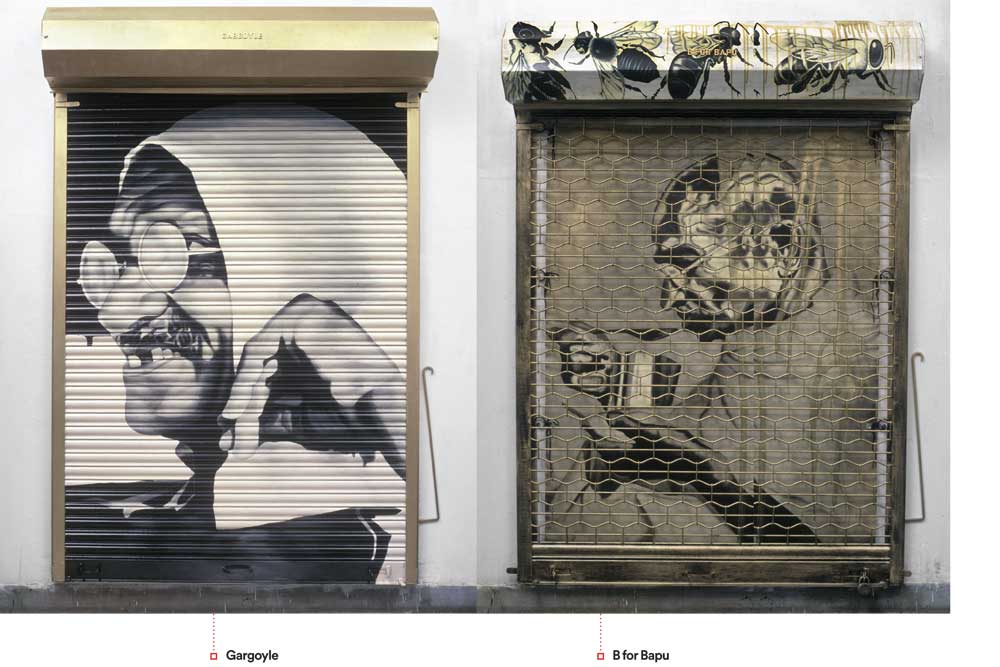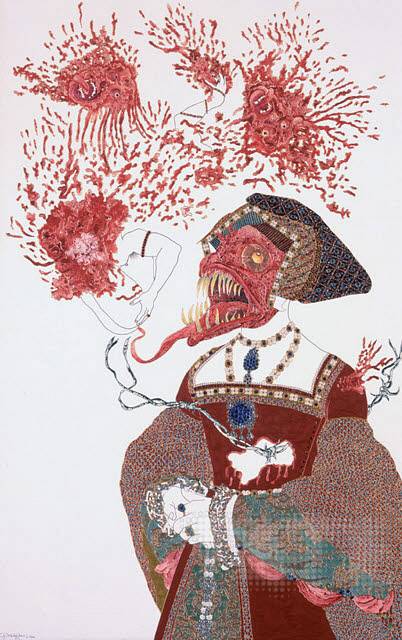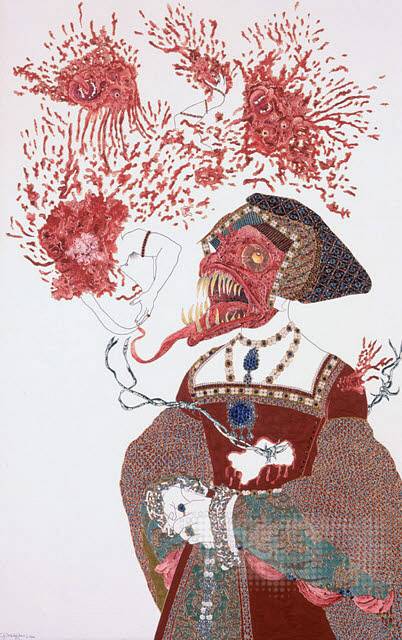In the realm of contemporary Indian art, the works of Atul Dodiya and Raqib Shaw hold significant importance. Their artistic contributions have not only captivated the Indian art scene but have also garnered international acclaim. Through their unique styles, innovative techniques, and thought-provoking narratives, Dodiya and Shaw have redefined the boundaries of artistic expression and cultural representation on a global stage.
Atul Dodiya: A Maestro of Multifaceted Narratives in Contemporary Indian Art
Atul Dodiya stands as a luminary in the realm of contemporary Indian art, his oeuvre a testament to his prowess in seamlessly weaving together diverse influences, narratives, and mediums. Born in Mumbai in 1959, Dodiya’s artistic journey spans over four decades, during which he has continually pushed the boundaries of expression, exploring themes ranging from religion and politics to culture and identity. With a practice that encompasses painting, sculpture, installation, and assemblage, Dodiya deftly navigates the complexities of modern India, offering poignant reflections on its societal, cultural, and historical landscapes.
Atul Dodiya’s artistic trajectory is marked by an eclectic mix of influences, drawing inspiration from sources as varied as Indian miniature painting, Western art history, popular culture, and everyday life. His early exposure to the vibrant streets of Mumbai, with its bustling markets, crowded alleys, and diverse communities, deeply influenced his artistic sensibilities, instilling in him a keen eye for detail and a profound empathy for the human condition. These formative experiences laid the groundwork for Atul Dodiya has distinctive artistic voice, characterized by its rich tapestry of imagery, symbolism, and social commentary.

Exhibited – Expacio Uno, Reina Sophia National Museum of Contemporary Art, Madrid, 2002
E.T. and Others, Walsh Gallery, Chicago, 2002
One of the hallmarks of Dodiya’s practice is his masterful blending of traditional and contemporary elements, seamlessly integrating age-old techniques with modern sensibilities. This fusion is perhaps most evident in his iconic series “Stations of the Cross” (1999-2000), a collection of mixed-media paintings that reimagines the traditional Christian motif within the context of contemporary India. Inspired by his Catholic upbringing and the religious diversity of Mumbai, Atul Dodiya’s interpretation of the Stations of the Cross offers a deeply personal and introspective journey through themes of suffering, redemption, and spiritual transcendence. Each painting in the series is a visual tableau that combines elements of religious iconography with contemporary imagery, inviting viewers to contemplate the universal themes of faith, sacrifice, and salvation.
Another recurring theme in Atul Dodiya’s work is his exploration of the intersection between politics and culture, often using his art as a tool for social critique and commentary. In “This is not a Fountain” (2010), Dodiya provocatively juxtaposes images of Mahatma Gandhi with a urinal, challenging viewers to confront the commodification of India’s national icons and the erosion of their moral and political significance in contemporary society. Similarly, in “The Gandhi Years” (2018), Dodiya revisits archival photographs of Gandhi’s life and legacy, recontextualizing them within the tumultuous socio-political landscape of modern India. Through his meticulous attention to detail and his incisive visual storytelling, Dodiya invites viewers to engage critically with the complexities of power, ideology, and memory.
Atul Dodiya’s engagement with cultural identity and heritage is also a central theme in his art, as he seeks to unravel the layers of history, tradition, and mythology that shape contemporary Indian society. In “Shutter Painting” (1994-2002), Atul Dodiya pays homage to the fading tradition of Indian street art, transforming mundane shutter doors into vibrant canvases that celebrate the everyday lives of ordinary people. By reclaiming these urban spaces as sites of artistic expression, Dodiya highlights the resilience and creativity of India’s urban communities, while also reflecting on the changing urban landscape and the encroachment of globalization.
Throughout his career, Atul Dodiya has continued to innovate and evolve, exploring new mediums and techniques while remaining true to his thematic preoccupations. In recent years, his experimentation with installation and assemblage has yielded striking results, as seen in works like “Broken Branches” (2015), a series of sculptures crafted from discarded window frames and shutters, which serve as poignant metaphors for the fragility of memory and the resilience of the human spirit. Similarly, in “The Death of Gandhi” (2019), Atul Dodiya creates a hauntingly beautiful tableau using found objects and archival photographs, offering a poignant meditation on the enduring legacy of India’s struggle for independence and the moral imperative of non-violence.
As we reflect on the rich tapestry of Atul Dodiya’s artistic legacy, it becomes clear that his contributions to contemporary Indian art are as diverse and multifaceted as the country itself. Through his bold experimentation, profound insights, and unwavering commitment to artistic integrity, Dodiya has not only enriched the cultural landscape of India but has also left an indelible mark on the global art world. With each brushstroke, each assemblage, and each installation, he continues to challenge, provoke, and inspire, inviting viewers to embark on a journey of self-discovery, empathy, and understanding. In the ever-changing landscape of contemporary art, Atul Dodiya stands as a beacon of creativity, compassion, and courage, reminding us of the transformative power of art to illuminate, provoke, and unite.
Notable Works:

Raqib Shaw: A Voyage into the Enchanted Realms of Art
An enchanting journey through the mesmerizing universe of Raqib Shaw—a name that evokes extravagance, meticulous detail, and a fusion of cultures.
The Artist’s Beginnings
A Childhood in Kashmir
Close your eyes and imagine: majestic snow-capped mountains, serene lakes, and gardens straight out of a fairy tale. This was the backdrop of Raqib Shaw’s childhood in Srinagar, Kashmir—a place often described as “Heaven on Earth.” Born in Calcutta in 1974, Shaw soaked up the beauty of this paradise, unknowingly laying the foundation for his artistic journey.
A Leap Across Continents
In 1989, amidst political turbulence, Shaw’s family made the move to New Delhi. There, he encountered the vibrant tapestry of Indian culture—Persian carpets, intricate miniatures, and textiles that whispered tales of bygone eras. But fate had more in store. In 1993, Shaw found himself in London, surrounded by the masterpieces of the National Gallery. It was a pivotal moment—a decision to wield the brush and stay in England to pursue his artistic calling.
The Alchemy of Shaw’s Art
A Visual Feast
Imagine stepping into a painting and being enveloped by a kaleidoscope of colors, patterns, and textures. Raqib Shaw’s works offer precisely that experience. His imagined worlds are filled with flora, fauna, and hybrid beings that blur the lines between reality and fantasy. These scenes are simultaneously captivating and disquieting, beckoning us to uncover their hidden narratives. It’s like wandering through the dreams of a cosmic magician.
The Artistic Process
Shaw’s creative journey is akin to alchemical sorcery:
Sketching: It all begins with small sketches on paper—characters, plants, and animals swirling in his mind’s eye.
Composition: These sketches evolve onto acetate sheets, each element meticulously placed. Then, they’re projected onto the canvas, forming the central composition.
Painting: Armed with a porcupine quill (yes, you read that right), Shaw manipulates pools of industrial paint—enamel, household, and car paint—to weave intricate patterns and textures.
Layers of Meaning: Beneath the opulence lies a darker undercurrent—a collection of intensely visceral and sensual images. Shaw’s works are like puzzles, layered with satire, irony, and reflections on the essence of existence itself.
Where East Meets West
A Fusion of Cultures
Shaw’s art transcends geographical and cultural boundaries. It’s a harmonious blend of Eastern mystique and Western sophistication:
Persian Influences: His intricate patterns evoke the richness of Persian carpets, while his delicate brushwork harkens back to the tradition of Indian miniatures.
Western Inspirations: Drawing from Northern Renaissance paintings and Surrealist imagery, Shaw creates a visual language that defies categorization.
Mythology and Poetry: His canvases are imbued with tales from ancient texts, seamlessly weaving together narratives from different cultures and epochs.
The Enigmatic Masterpieces
“Jane” (2006): A painting as enigmatic as its title. Beauty, decadence, and mysteries intertwine in this mesmerizing masterpiece.

“Paradise Lost” (2001–2011): A series that explores themes of desire, pleasure, and excess—the forbidden fruits of human existence.

For those eager to dive deeper into Raqib Shaw’s fantastical world, here are some resources to explore:
Raqib Shaw – Wikipedia
What’s So Unique About Raqib Shaw’s Cross-Cultural Fantasy World?
Raqib Shaw: Ballads of East and West
Official Raqib Shaw Studio

